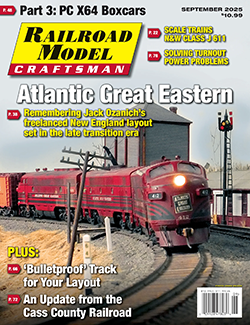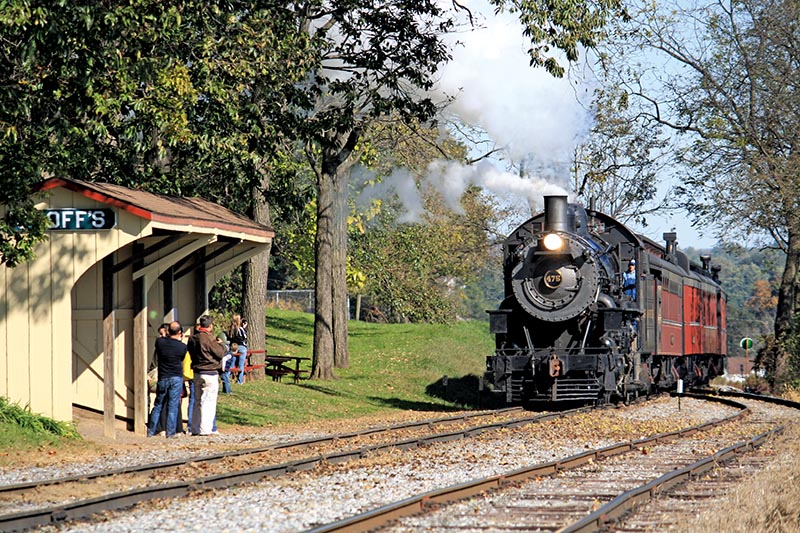 Picture this: It’s a hot summer day in Burlington, Vt., as you wait for the arrival of Rutland Railway Train 57, which will take you and your family to your lakeside cottage at Starr Farm Beach. The northbound train, with two coaches and a baggage car, arrives at the station. The door opens, and you hurriedly board your family during the short five-minute stop. You barely settle in for the trip to the cottage as the train lurches forward. It seems like only minutes have passed when the conductor announces, “Next stop, Starr Farm Beach.” The brakes squeal, and 57 comes to a halt. You quickly gather your family and head for the rear door. As you step off the train, Brother Bill and his family, dressed in their summer best, greet you at the small Starr Farm Beach shelter. You walk back to the baggage car, which is spotted on the crossing since the flag stop platform is so tiny. The baggage man is busy unloading your baggage. You notice the open-air shelter has been repainted with the familiar railroad colors since last summer’s visit, and the cedar shingle siding is weathering well.
Picture this: It’s a hot summer day in Burlington, Vt., as you wait for the arrival of Rutland Railway Train 57, which will take you and your family to your lakeside cottage at Starr Farm Beach. The northbound train, with two coaches and a baggage car, arrives at the station. The door opens, and you hurriedly board your family during the short five-minute stop. You barely settle in for the trip to the cottage as the train lurches forward. It seems like only minutes have passed when the conductor announces, “Next stop, Starr Farm Beach.” The brakes squeal, and 57 comes to a halt. You quickly gather your family and head for the rear door. As you step off the train, Brother Bill and his family, dressed in their summer best, greet you at the small Starr Farm Beach shelter. You walk back to the baggage car, which is spotted on the crossing since the flag stop platform is so tiny. The baggage man is busy unloading your baggage. You notice the open-air shelter has been repainted with the familiar railroad colors since last summer’s visit, and the cedar shingle siding is weathering well.
The Starr Farm Beach flag stop shelter was a simple design measuring 11×17 ft., with no door but windows on each end so you can see your train approaching. The shelter provided a good place to get out of the rain while waiting for a train. Similar flag stop styles could be found on many railroads across the country.
Not all towns had train service, requiring travelers to go some distance to the nearest railway connection. This is where flag stops come into play. Flag stops were destinations often located far from any villages or towns, rural spots beside a road where one could connect with the larger world nearby. Amazingly, it was the responsibility of the passenger to flag down the crew to get them to stop, either by waving a flag or whatever was handy.
Amazingly, some of these flag stops have survived, including at heritage railways in the United States and Canada. Others have been preserved and repurposed as storage sheds, like the Central Vermont Railway State Line flag stop (located at the border of Massachusetts and Connecticut), which now serves a golf course in the Palmer, Mass., area. In Maine, you can find several flag stops — some are original rebuilt structures, and others are recreations — like those on the two-foot gauge Wiscasset, Waterville & Farmington Railway Museum. The Strasburg Rail Road in Pennsylvania features one about halfway along its line to Paradise where passengers can stop off at a picnic grove.
Like stations from the early railroad era, many flag stops featured some type of decorative details that made them unique and stand out from other structures. From what I’ve seen, it doesn’t appear that the railroads followed a standard design for flag stops, since each station stop tends to be a bit different.
Flag stops are not just a thing from our past; they still remain in use today. Many of the smaller towns serviced by VIA Rail and Amtrak have a shelter of some sort, similar to the flag stops of the past. As was done in early eras, each structure appears to be distinctly different from each other. In my area, there are four VIA stops, each different from the next.
Interestingly, today no flags are required for a train to stop. I can remember years ago, while doing my passenger training for CN, we would have to watch for passengers at these locations, as some were not regular stops. Nowadays, with passenger train speeds of 80 mph or more, they can really fly past these locations. Technology today allows passengers requiring a train to stop at these locations to purchase their tickets online, which alerts the train crew where stops are needed, including how many passengers to watch for. Technology also provides passengers with a way to track the train’s location at all times before they board.
As modelers, these small flag stops can add interest to our operating sessions. Over the years, I have built several flag stops and find them quite easy to make, whether from a kit or from scratch. Often, a smaller leftover structure can be transformed into a small flag station. By adding a few of these small stations along the subdivision, train crews would need to watch for passengers and flag signals located there. These types of structures take up almost no room on a layout, making them easy to include regardless of the era you model. —George Dutka



